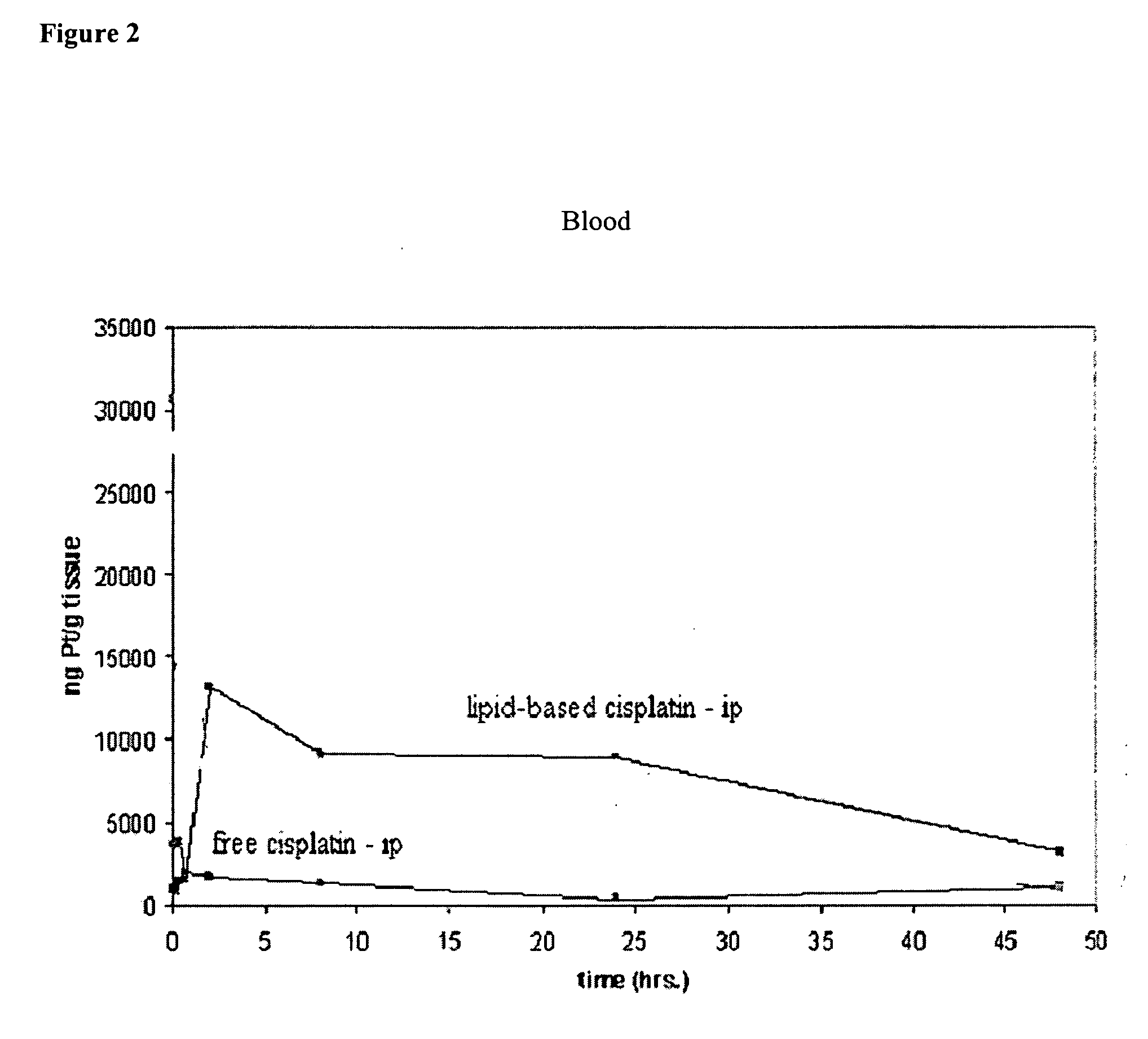Methods of treating cancer with lipid-based platinum compound formulations administered intraperitoneally
a technology of lipid-based platinum and compound formulations, which is applied in the direction of biocide, heavy metal active ingredients, drug compositions, etc., can solve the problems of dose limitation factor, high toxicity of active platinum compounds such as cisplatin, and extreme nephrotoxicity, so as to improve nephrotoxicity, potent and efficient cancer treatment, and improve the effect of treatment
- Summary
- Abstract
- Description
- Claims
- Application Information
AI Technical Summary
Benefits of technology
Problems solved by technology
Method used
Image
Examples
example 1
[0096] Reduction of sub-acute toxicity of cisplatin by iv or ip administration when administered as a lipid-based formulation. ICR mice, male and female, 6-7 weeks old, were divided into 24 groups with 10 mice in each. Five mice were housed in each cage with free access to standard mouse food and water. Each group of mice was injected with lipid-based cisplatin formulations prepared according to the following. The lipid-based cisplatin formulation used here contained 1 mg / ml cisplatin, 16 mg / ml DPPC, and 7.9 mg / ml cholesterol in 0.9% NaCl solution. An aliquot (50%) of the sample was treated by 3 cycles of cooling to 4° C. and warming to 50° C. The aliquot, in a test tube, was cooled by refrigeration, and heated in a water bath. The resulting unentrapped cisplatin (free cisplatin) was washed away by dialysis. The lipid-based cisplatin in the form of liposomes were injected through iv (tail vein) or ip route. The liposomes had a mean diameter of about 0.39 μm. The formulations, doses,...
example 2
[0099] Pharmacokinetics and organ distribution in animals of ip and iv injected lipid-based cisplatin and cisplatin (Part I). The mice (the same as from Example 1) were divided into 4 groups with 24 mice in each. They were injected with ip lipid-based cisplatin (12 mg / kg), ip cisplatin (12 mg / kg), iv lipid-based cisplatin (8 mg / kg), and iv cisplatin (8 mg / kg), separately. The lipid-based cisplatin formulation were prepared in the same manner as in Example 1. At each designed time point, e.g., 2-5 min, 20 min, 40 min, 2 h, 8 h, 1 day, 2 days, and 3 or 5 days after injection, 3 mice from each group were anesthetized by ip injection of 35-50 mg / kg of Nembutal, then the blood was drown and heart, kidney, liver, lung, small intestine, and spleen were resected and homogenized after adding 4-fold pure water. The Platinum concentration in each sample was determined with AA method. The content of Pt (μg of Pt in 1 ml of blood or 1 gram of tissue) was calculated and used for presenting the ki...
example 3
[0101] Pharmacokinetics and organ distribution in animals of ip and iv injected lipid-based cisplatin and cisplatin (Part II). Sixty ICR mice (female, 7 weeks old) were divided into 4 groups. They received intraperitoneal or intravenous injection of L-CDDP or CDDP, separately. The dose was 12 mg / kg for ip L-CDDP and 8 mg / kg for the rest of treatment groups. At each designed time point, three to four mice were anaesthetized with 70 mg / kg of Nembutal ip (e.g., 3, 20, and 40 min, and 2, 8, 24, 48, and 72 h). The blood was drawn from the inferior vena cava. Organs including duodenum, kidney, liver, lung, and spleen were resected from the mice. The blood and organ samples were homogenized in distilled water (4-fold of the sample weight) and digested with nitric acid. The platinum concentration in each sample was measured by Inductively Coupled Plasma-Mass Spectrometer (ICP-MS). The pharmacokinetics profiles (FIGS. 3-7, all Y-axes are concentration of μg platinum in one gram of tissue or ...
PUM
| Property | Measurement | Unit |
|---|---|---|
| concentration | aaaaa | aaaaa |
| mol % | aaaaa | aaaaa |
| mol % | aaaaa | aaaaa |
Abstract
Description
Claims
Application Information
 Login to View More
Login to View More - R&D
- Intellectual Property
- Life Sciences
- Materials
- Tech Scout
- Unparalleled Data Quality
- Higher Quality Content
- 60% Fewer Hallucinations
Browse by: Latest US Patents, China's latest patents, Technical Efficacy Thesaurus, Application Domain, Technology Topic, Popular Technical Reports.
© 2025 PatSnap. All rights reserved.Legal|Privacy policy|Modern Slavery Act Transparency Statement|Sitemap|About US| Contact US: help@patsnap.com



